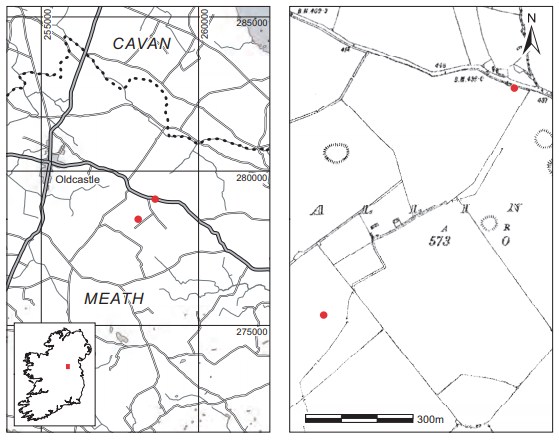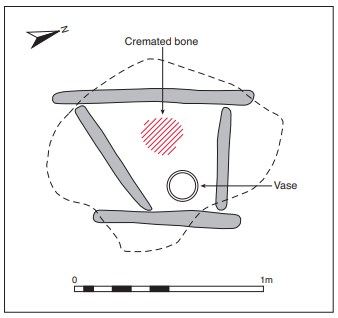1935:007 - BALLINVALLY, CO. MEATH, Meath
County: Meath
Site name: BALLINVALLY, CO. MEATH
Sites and Monuments Record No.: Grave 1 &2 - SMR ME009-060001Grave 3 - SMR ME009-055
Licence number: E1127
Author: JOSEPH RAFTERY
Author/Organisation Address: —
Site type: Early Bronze Age graves
Period/Dating: —
ITM: E 725744m, N 727917m
Latitude, Longitude (decimal degrees): 53.286637, -6.114106
Introduction
In July 1935, during the erection of a fence near Oldcastle, Co. Meath, two short cists were discovered approximately 0.2m below ground level by workers for the Land Commission. They were reported to the Office of Public Works, who informed the NMI. On 4 September of the same year, a third cist containing a cremation and a vase was discovered during the same works. This site was reported to the NMI by Dr Michael Hanley, who delivered the finds to the Museum and kept the site intact pending an investigation. A rescue excavation was undertaken by Dr Joseph Raftery. Unfortunately, the latter (cist 3) was the only cist to be investigated properly, as the other two had been largely dug out prior to Raftery’s visit. This report is based on Raftery’s field notes and on R.G. Inkster’s report on the human remains.

Location (Fig. 3.128)
The site was in the townland of Ballinvally, north-west Co. Meath.230 The first two cists231 were located within 1.2m of each other, and the third232 lay some 400m to the north. The site was at the bottom of Slieve na Calliagh on the northern side (the central hill of the Loughcrew foothills), about 670m from the summit. Cists 1 and 2 were located in the approximate centre of a circular enclosure, with very slight elevation at an altitude of 120–150m, and surrounded by a very shallow ditch measuring approximately 25m in diameter. Cist 3 was approximately 400m north of the first two cists, at an altitude of 150–180m above sea level. Immediately west of the former was a standing stone, and further west two others.
Description of site
Grave 1
Very little is recorded in relation to the structure of this cist. It was presumably rectilinear in shape, measuring 0.91m long by 0.76m wide by 0.46m deep. The structure was not apparently covered by a capstone. According to the finders, the cist contained some ‘dark earth and charcoal’ but no artefacts were found. The cist was filled with ‘rather muddy yellow clay’ which had a largenumber of charcoal fragments mixed through. It had been emptied before the site was visited.
Grave 2
According to Raftery, this cist was approximately the same size as cist 1 233 but, unlike the former, had been sealed by a large capstone. The cist had also been heavily disturbed prior to Raftery’s investigation and the side stones were broken. No further details are recorded. The grave contained a few fragments of bone and, like cist 1, was filled with yellow clay with charcoal inclusions. Raftery does not state whether the bone was burnt or unburnt. No associated artefacts appear to have been found in the grave.

Grave 3
This was wedge-shaped in plan, with its longer axis running north/south. Internally it measured 0.61m long by 0.31m wide by 0.38m deep (Fig. 3.129). It was composed of four side stones set on edge, one forming each wall. There was no evidence for packing stones around the cist. The grave was covered by a large ovoid capstone, which was decorated on its underside (i.e. the side facing into the cist chamber) with four sets of concentric circles. It measured 1.07m long by 0.76m wide. The cist does not appear to have been paved and the pit dug to receive it was apparently not located.
The grave contained the cremated remains of an adult individual (1935:541) accompanied by a vase (1935:540). The vase had been placed upright in the centre of the northern end wall of the cist and the cremation was deposited in the centre of the cist. According to a local person who had visited the site, a few pieces of flint were found among the bones.234 Dr Inkster’s report on the bones states that they represented the remains of an adult, approximately 30 years of age. The sex of the individual could not be determined. Inkster also stated that, while the bones had been subjected to fire, the cremation had been much less complete than was usual.
Anomalous vase, 1935:541 (Fig. 3.130)
The vase has been classified as an anomalous type (Ó Ríordáin and Waddell 1993, 284). It is of thick, coarse fabric with frequent grits and bears roughly incised ornament. The rim is bevelled and is decorated with short incised lines. The neck is decorated with vertically disposed rows of rough fingernail impressions. The shoulder is decorated with a row of fingernail impressions. The body is sparsely decorated with very roughly incised lines, in some places forming a very crude chevron pattern. The base of the vessel is plain. Overall, the decoration on the vessel is rough and irregular.
Dimensions: H 14.9cm; ext. D rim 14.65cm; D base 6.5cm; T wall 1.2cm.

Comment
As nothing survives from graves 1 and 2, there are no samples available for analysis or dating. The human remains from grave 3 have not been dated. The vessel is an anomalous type and cannot easily be fitted into any of the stages of vase development as discussed by Brindley (2007). Shee (1972, 228–31) has described the decorated stone found at Ballinvally covering cist 3. The stone has four sets of concentric circles (not all complete), three with three rings and one of two rings. The occurrence of a decorated capstone is unusual but has been recorded at other sites, e.g. Moylough, Co. Sligo, Hempstown Common, Co. Kildare (Shee 1972, 231), and Crumlin 1, Co. Louth.235 Shee Twohig (2001) has discussed the cists in the wider context of a prehistoric ritual landscape, noting the wide variety of monument types, including standing stones, a henge, carved stone and a possible cursus, in the immediate area.
Graves 1 and 2 were contained within a barrow and it is unfortunate that nothing survives of their contents. Grave 3 was situated some 400m away from it and clearly belongs to a separate site, but whether this is a single isolated cist or part of a larger cemetery is not known. It was close to a large enclosure. These sites are located in an area rich in prehistoric remains from at least Neolithic times. There is also a rich collection of prehistoric finds from the area collected by E. Crofton Rotheram and the Revd Mr C.K. Kevin, which is in the NMI.
HUMAN REMAINS
R.B. INKSTER
Cist 3 (1935:541)
The remains consist of a large number of pieces, most of which are identifiable. They have been subjected to fire but the cremation has been much less complete than is usual. The bones are human and no animal remains were found. The fragments come from all parts of the body but there is no duplication beyond what is normal, so that there would appear to be only one individual represented. The remains are those of an adult of rather small build and fairly young—about 30 years old. There is no evidence as to sex.
REPORT ON THE SLABS FROM THE CIST
J.S. JACKSON
The rock is medium-grained, non-calcareous grit which is but moderately indurated, the interstitial siliceous cement only partially filling the voids. The lithology suggests an Upper rather than a Lower Palaeozoic age; the leuocratic nature of the rock coupled with its semi-decoherence are typical of Old Red Sandstone sediments but would be compatible with some Carboniferous sandstone beds. Provenance may have been the arenaceous bands locally developed at and near the base of Dinantian (Lower Carboniferous) succession, many of which are decoherent, semi-friable and decalcified and which outcrop near Oldcastle, Kilnaleck, Granard etc.
230. Parish of Oldcastle, barony of Fore. Graves 1 and 2 (found July 1935) are noted as SMR ME009-060001— but are not in the correct location. A map recently found in the NMI archives shows the location in an
adjoining field to the south at IGR 258075 278172; grave 3, SMR ME009-055—, is located at IGR 258210 278900. See http://www.archaeology.ie/smrmapviewer/mapviewer.aspx (accessed 16/03/2009).
231. Hereafter referred to as graves 1 and 2.
232. Hereafter referred to as grave 3.
233. Exact measurements not provided.
234. These do not seem to have been acquired by the Museum.
235. 98E0615, Crumlin 1, Co. Louth; https://www.excavations.ie (accessed 16/03/2009).
